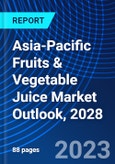This report comes with 10% free customization, enabling you to add data that meets your specific business needs.
1h Free Analyst TimeSpeak directly to the analyst to clarify any post sales queries you may have.
According to the research report Asia Pacific Fruit & Vegetable Juice Market Outlook, 2028, the market is expected to grow at 7.15% CAGR by 2023-28. Urbanization, globalization, and Western influences have led to changes in dietary patterns in the Asia Pacific region. There is a shift towards a more diverse and inclusive diet that includes a greater consumption of fruits and vegetables. Fruit and vegetable juices offer a convenient way to incorporate these essential nutrients into daily routines. The beverage industry as a whole is expanding in the Asia Pacific region, driven by factors such as changing consumer preferences, urbanization, and the availability of a wide range of beverage options. Fruit and vegetable juices are part of this growth trajectory, benefiting from the overall expansion of the beverage market. Based on the types consider in this report are Fruit Juice, Vegetable Juice, Fruit & Vegetable Blends and Nectar. In Asia pacific region the Fruit juice is hold the highest market shares, many societies in the Asia Pacific district have a well-established custom of consuming organic product based drinks. Fruits have cultural significance in a variety of festivals, rituals, and ceremonies. Fruit juices are therefore deeply ingrained in the regional culinary practices and daily routines. Traditional medicine practices in the Asia Pacific region often emphasize the health benefits of specific fruits. Certain fruits are believed to possess medicinal properties and are incorporated into traditional remedies. This cultural association reinforces the consumption of fruit juices for their perceived health-enhancing properties. Mango juice is a widely enjoyed fruit juice in the region. It can be diluted with water or blended with milk to create a refreshing beverage. As well as the Orange juice is another popular choice, especially during breakfast. It can be mixed with water or combined with milk for a creamy variation.
There are several Government Initiative regarding the Fruit & Vegetable Juice market, Governments in the Asia Pacific region generally have regulations in place to ensure the safety and quality of food products, including fruit and vegetable juices. These regulations may cover aspects such as hygiene standards, labeling requirements, and permissible additives. Many countries have established quality standards for fruit and vegetable juices to protect consumers and promote fair trade. These standards may specify parameters such as minimum fruit content, permissible additives, and maximum levels of contaminants. Governments often implement certification programs and conduct inspections to ensure compliance with food safety and quality standards. This may involve regular inspections of juice manufacturing facilities, testing of products, and granting certifications to businesses that meet the prescribed criteria. Governments may have specific regulations pertaining to the import and export of fruit and vegetable juices. These regulations may include requirements for documentation, labeling, and compliance with sanitary and phytosanitary measures. Governments often have import and export regulations that apply to fruit and vegetable juices. These regulations may include requirements for documentation, labeling, and compliance with sanitary and phytosanitary measures. They aim to ensure that imported and exported juices meet the necessary quality and safety standards.
Based on the countries cover in this report are China, japan, India, Australia and South Korea, in Asia Pacific region the China is leading the Fruit & Vegetable juice market in 2022. China has the largest population in the world after India, which creates a massive consumer base for the fruit and vegetable juice market. The sheer size of the population presents significant market opportunities and drives demand for a wide range of products, including juices. China's rising middle class has experienced increased purchasing power and improved living standards. This has led to higher consumer spending on healthier and premium products, including fruit and vegetable juices. The growing middle class is a key driver of the market's expansion. The Chinese government has implemented various policies and initiatives to support the agricultural and food processing sectors. These efforts include subsidies, infrastructure development, and promotional campaigns to boost the consumption of locally produced fruits and vegetables, including their processed forms like juices.
Based on the Distribution channel includes the Hypermarket/supermarket, Online, Convenience Stores and Others (Cafes, Clubs, Restaurant’s, Etc.). In the Asia Pacific region the hypermarket/supermarket is having the highest market share in this region. There are several hypermarket and supermarket that offer the Fruit juice and vegetable juice with the many variety of juice, there are several Hypermarket/supermarket that offer the fruit and vegetable juice, are the Carrefour, Tesco, Walmart and Aeon. These large-format stores typically have a vast selection of products, including fruits, vegetables juice, household items, and more. They offer a wider variety of brands, flavors, and options compared to smaller stores, giving consumers more choices. Supermarkets and hypermarkets require significant infrastructure and logistics capabilities to operate efficiently. As the Asia Pacific region experiences economic growth and urbanization, there has been an expansion of infrastructure, including improved transportation networks and logistics systems, making it easier to establish and manage large-format retail stores.
Considered in this report
- Geography: Asia Pacific
- Historic year: 2017
- Base year: 2022
- Estimated year: 2023
- Forecast year: 2028
Aspects covered in this report
- Asia Pacific Fruit & Vegetable Juice market with its value and forecast along with its segments
- Country-wise Fruit & Vegetable Juice market analysis
- Various drivers and challenges
- On-going trends and developments
- Top profiled companies
- Strategic recommendation
Countries covered in the report:
- China
- Japan
- India
- Australia
- South Korea
By Type
- Fruit Juice
- Vegetable Juice
- Fruit & Vegetable blend
- Nectar
By Distribution Channel
- Supermarket/hypermarket
- Convenience Stores
- Online
- Others (Cafes, Clubs, Restaurant’s, Etc.)








